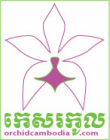Fruiting
In horticulture, pollination is artificially made for fruition to arrive, and the conditions in greenhouses should be at this point suitable for the forming of eggs.
The rapid blowing up of the peduncle is the result of penetration of pollinia and the simultaneous growth of several pollen tubes.
The intensity of this effect can be compared to a "sexual bombshell" (6 million male gametes by a pollinia!).
But thereafter, two processes must be synchronized: the development of egg division by a series of female cells meristematic and fertilization of the latter by the generative nucleus of pollen.
So the seeds of the fruit are not always well developed. However, there are species that form the fruit easily (eg, Epidendrum and Encyclia) even during flowering (often in the case of inbreeding).
The comparative study of flowering and fruiting allow us to know the reproduction potential of different species of orchids and more importantly, the adaptability of the orchids to growing conditions.
by Marpha TELEPOVA-TEXIER
Département des Jardins Botaniques et Zoologiques du Muséum national d’Histoire naturelle, USM 0602, case postale 39, 57 rue Cuvier, 75005 Paris; telepova@gmail.com
The rapid blowing up of the peduncle is the result of penetration of pollinia and the simultaneous growth of several pollen tubes.
The intensity of this effect can be compared to a "sexual bombshell" (6 million male gametes by a pollinia!).
But thereafter, two processes must be synchronized: the development of egg division by a series of female cells meristematic and fertilization of the latter by the generative nucleus of pollen.
So the seeds of the fruit are not always well developed. However, there are species that form the fruit easily (eg, Epidendrum and Encyclia) even during flowering (often in the case of inbreeding).
The comparative study of flowering and fruiting allow us to know the reproduction potential of different species of orchids and more importantly, the adaptability of the orchids to growing conditions.
by Marpha TELEPOVA-TEXIER
Département des Jardins Botaniques et Zoologiques du Muséum national d’Histoire naturelle, USM 0602, case postale 39, 57 rue Cuvier, 75005 Paris; telepova@gmail.com
